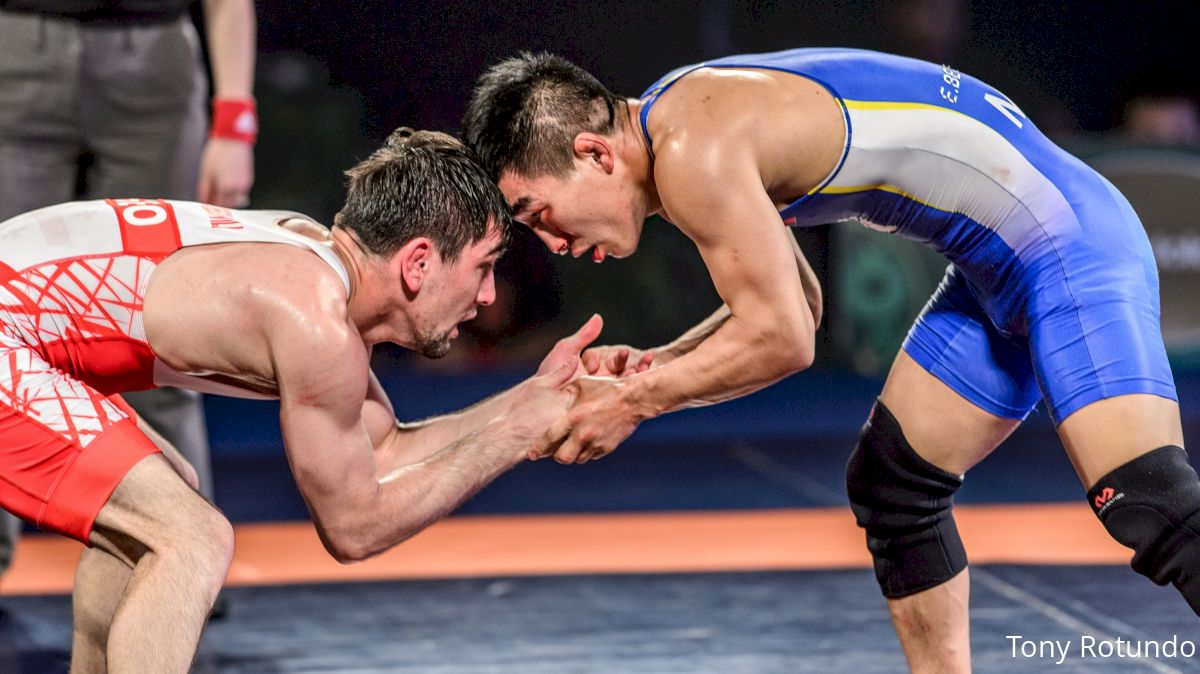UWW Announces Major Changes To International Wrestling
UWW Announces Major Changes To International Wrestling
United World Wrestling has announced major changes coming, including the return of 10 weight classes

While the NCAA tournament was going on, United World Wrestling officially announced a number of changes to the sport as a whole. Now that we've had time to digest, read and unpack every piece of the three page memo from president Nenad Lalovic to all the national federations, let's try to make sense of it all.
This is unprecedented for our sport. Between the 1969 world championships and 1996 Olympics, Men's Freestyle and Greco-Roman both had this many weights. But it is uncharted territory for the women, who were only included at the world championships as recently as 1987. Between then and 1995, women had nine weight classes.
The only thing we don't know is what those 10 weights will be each for each style, and if MFS and GR will go back to having matching weight classes. That will be decided at the UWW bureau meeting before the 2017 world championships in Paris, for the senior, junior and U23 levels. Those weights will take effect on January 1, 2018.
To my understanding, the current world rankings are done by one man and only have some rough criteria for suggested rank-ability. Now, the individual rankings will use those same point values, as well as values for continental championships (Pan Ams, Euros, etc) and "selected international tournaments," which would likely include events such as the Yarygin, Klippan and Zagreb Open.
There are also other minor issues, such as the strength of Euros over every other continent, or if Cuba and USA end up on the same side at Pan Ams but may have the top two athletes. The most glaring, which is solved by using that athlete at continentals, is that an athlete could be seeded behind two they have beaten.
An example would be Abdulrashid Sadulaev. If he doesn't wrestle at Euros, which he has never done, he would have 25 points going into Paris. Say the 86kg finals is Sharif Sharifov (AZE) over Selim Yasar (TUR). This would give Yasar the top seed in Paris (20 Rio pts + 10 Euros), over two athletes who beat him. Sharifov would get the 2 seed (15 Rio + 12 Euros) over Sadulaev. Not great optics, however, standardization is far more desirable than coaches speaking dozens of different languages sitting in a room arguing about a bracket.
Now, this is not final. It will be tested at the 2017 Cadet European and 2017 Cadet world championships. Based on the results of those events, it may be adopted for all levels starting in 2018. It also appears the current system of random draw (minus top four) and repechage being only for athletes who lose to finalists is still in place.
Another big one that would have helped the United States at last year's Pan Am Olympic qualifier is the expansion of round robin from five to seven athletes. Currently, a line bracket can be used for six or more athletes, but if five or fewer everyone wrestles everyone. Now, a line bracket must consist of at least eight athletes; if there are seven or fewer, they will be split into two separate round robin groups.
Lastly, a request was made to have additional cameras for challenges at major events.
As mentioned above, the specific weight classes have not been finalized. FivePointMove published an article in January listing weights for presumably GR and MFS, though the author Timmy Hands mentioned he did get confirmation with UWW about those weights. Another memo in circulation for several weeks intimates the return of the five-point throw to freestyle, as well as modifications to correct throws, passivity and cautions.
Below is the entire three page letter from Lalovic. Stay tuned for more updates as items are ratified, memos are circulated and the rulebook continues to get updated.
UWW Rule Changes
1) Ten Weights!
There has been no bigger bone of contention in the American wrestling community (not sure what the foreign crowd felt) than the number of weights. While the 2020 Olympics in Tokyo are locked in to six weights, and this year's worlds will have eight each, we will have two straight world championships with 30 total weight classes, 10 for each style.This is unprecedented for our sport. Between the 1969 world championships and 1996 Olympics, Men's Freestyle and Greco-Roman both had this many weights. But it is uncharted territory for the women, who were only included at the world championships as recently as 1987. Between then and 1995, women had nine weight classes.
The only thing we don't know is what those 10 weights will be each for each style, and if MFS and GR will go back to having matching weight classes. That will be decided at the UWW bureau meeting before the 2017 world championships in Paris, for the senior, junior and U23 levels. Those weights will take effect on January 1, 2018.
2) Rankings Overhaul
Currently, the placing system for worlds follows a a10 point scale, meaning that three bronzes (8 pts each) are the equivalent of two golds and a seventh (10s + a 4) in a team race. Now, it will be very similar to Formula 1 style scoring, with a champ being worth 25 points. You can see the rest of the point distributions at the bottom of this article. How spots 7-10 at a tournament are determined does not change. See here for a primer on that format.To my understanding, the current world rankings are done by one man and only have some rough criteria for suggested rank-ability. Now, the individual rankings will use those same point values, as well as values for continental championships (Pan Ams, Euros, etc) and "selected international tournaments," which would likely include events such as the Yarygin, Klippan and Zagreb Open.
3) Separation At 2017 Worlds
I'm not calling it "seeding" because it's not done by a coaches vote. Essentially, the results of the Olympics, non-Olympic weight world championships, and upcoming continental championships will determine the top four "seeds" as we would typically see in a folkstyle bracket. Additionally, points do not carry over if you change weights. For example, if Olympic champion Soslan Ramonov is Russia's 70kg representative in Paris, he does not get any separation points because his gold medal was at 65kg.There are also other minor issues, such as the strength of Euros over every other continent, or if Cuba and USA end up on the same side at Pan Ams but may have the top two athletes. The most glaring, which is solved by using that athlete at continentals, is that an athlete could be seeded behind two they have beaten.
An example would be Abdulrashid Sadulaev. If he doesn't wrestle at Euros, which he has never done, he would have 25 points going into Paris. Say the 86kg finals is Sharif Sharifov (AZE) over Selim Yasar (TUR). This would give Yasar the top seed in Paris (20 Rio pts + 10 Euros), over two athletes who beat him. Sharifov would get the 2 seed (15 Rio + 12 Euros) over Sadulaev. Not great optics, however, standardization is far more desirable than coaches speaking dozens of different languages sitting in a room arguing about a bracket.
4) Two-Day Competition Format
This would seem to benefit America greatly. It would go from day before weigh-ins with all matches being wrestled in one day, to a two-day format with both weigh-ins being the morning of the competition. Day one would consist of the qualification round up to and including the semis, day two would consist of repechage and the finals. There will be a two kilogram allowance on the second day of competition.Now, this is not final. It will be tested at the 2017 Cadet European and 2017 Cadet world championships. Based on the results of those events, it may be adopted for all levels starting in 2018. It also appears the current system of random draw (minus top four) and repechage being only for athletes who lose to finalists is still in place.
5) In Match Rules
Points of emphasis are passivity and par terre. It appears there will be updates continually being made throughout the year to the rulebook, with par tree in particular being tested at the Dan Kolov & Nikola Petrov tournament in April. The latest version of the UWW rule book, which was updated just this month, can be found here.6) Miscellaneous
It appears there will be a modification to anti-doping violations for team events, with a positive test resulting in the elimination of the whole team from that event. They define eliminate as, "any athlete who tests positive during a team competition (i.e. World Cup) will invalidate their entire team's result for the event."Another big one that would have helped the United States at last year's Pan Am Olympic qualifier is the expansion of round robin from five to seven athletes. Currently, a line bracket can be used for six or more athletes, but if five or fewer everyone wrestles everyone. Now, a line bracket must consist of at least eight athletes; if there are seven or fewer, they will be split into two separate round robin groups.
Lastly, a request was made to have additional cameras for challenges at major events.
As mentioned above, the specific weight classes have not been finalized. FivePointMove published an article in January listing weights for presumably GR and MFS, though the author Timmy Hands mentioned he did get confirmation with UWW about those weights. Another memo in circulation for several weeks intimates the return of the five-point throw to freestyle, as well as modifications to correct throws, passivity and cautions.
Below is the entire three page letter from Lalovic. Stay tuned for more updates as items are ratified, memos are circulated and the rulebook continues to get updated.
UWW Rule Changes
Related Content
 Replay: Mat 2 - 2024 US Open Wrestling Championships | Apr 25 @ 4 PM
Replay: Mat 2 - 2024 US Open Wrestling Championships | Apr 25 @ 4 PMApr 26, 2024
 Replay: Mat 10 - 2024 US Open Wrestling Championships | Apr 25 @ 4 PM
Replay: Mat 10 - 2024 US Open Wrestling Championships | Apr 25 @ 4 PMApr 26, 2024
 Replay: Mat 9 - 2024 US Open Wrestling Championships | Apr 25 @ 4 PM
Replay: Mat 9 - 2024 US Open Wrestling Championships | Apr 25 @ 4 PMApr 26, 2024
 Replay: Mat 17 - 2024 US Open Wrestling Championships | Apr 25 @ 4 PM
Replay: Mat 17 - 2024 US Open Wrestling Championships | Apr 25 @ 4 PMApr 26, 2024
 Replay: Mat 16 - 2024 US Open Wrestling Championships | Apr 25 @ 4 PM
Replay: Mat 16 - 2024 US Open Wrestling Championships | Apr 25 @ 4 PMApr 26, 2024
 Replay: Mat 1 - 2024 US Open Wrestling Championships | Apr 25 @ 4 PM
Replay: Mat 1 - 2024 US Open Wrestling Championships | Apr 25 @ 4 PMApr 26, 2024
 Replay: Mat 5 - 2024 US Open Wrestling Championships | Apr 25 @ 4 PM
Replay: Mat 5 - 2024 US Open Wrestling Championships | Apr 25 @ 4 PMApr 26, 2024
 Replay: Mat 4 - 2024 US Open Wrestling Championships | Apr 25 @ 4 PM
Replay: Mat 4 - 2024 US Open Wrestling Championships | Apr 25 @ 4 PMApr 26, 2024
 Replay: Mat 6 - 2024 US Open Wrestling Championships | Apr 25 @ 4 PM
Replay: Mat 6 - 2024 US Open Wrestling Championships | Apr 25 @ 4 PMApr 26, 2024